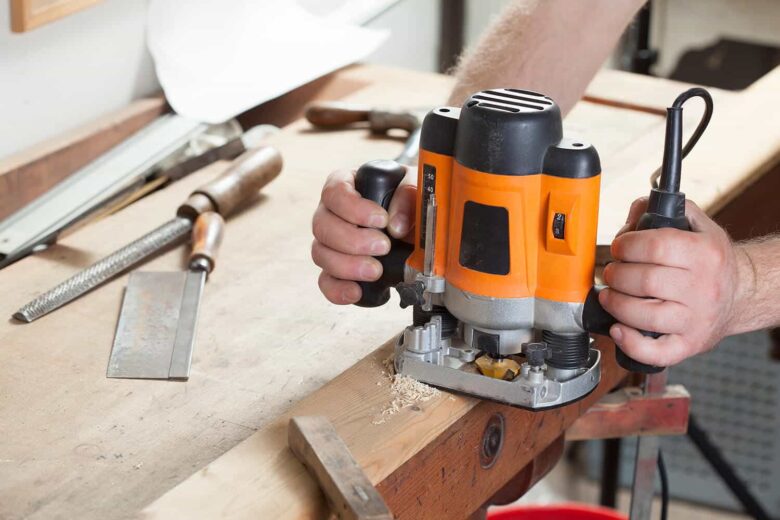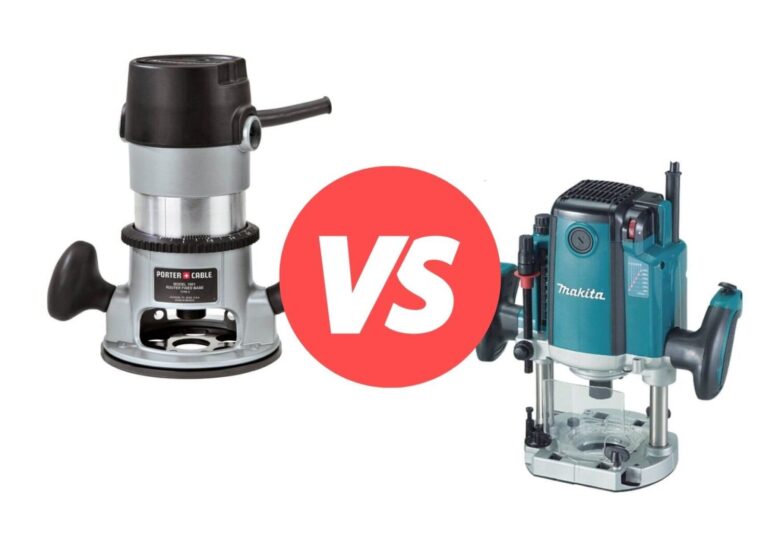Cabinetry and other woodworking tasks have become easier with the invention of routers. They are applicable for editing, straight cutting, veining, trimming, grooving, and so more. Sounds great? But, it will be possible only if you’ve your hands on the right kind of tool.
There are two main types of routers. First is “Regular routers,” which are old-school and versatile, and second is “Plunge routers,” which are modern and precise. Both router devices have excellent or bad properties, which is why it is important to study before purchasing one. There is much more to say about both of these router kinds, so let’s begin the discussion.
What We Have Covered
Plunge Router vs. Regular Router – Which one is better?
The primary difference between a plunge router and a regular router is “BASE.” There are some other factors too that make these routers different from each other. Besides, both routers allow the woodworkers to perform a variety of tasks at home or site.
A Plunge Router
Plunge Router is an adjustable router device that allows you to regulate the height at your convenience. The base of this router stays flat on the material which you’ve selected for your work. It excels far from the edge, typically at the middle of your wood piece, of course, when you decide to cut.
If you’re an entry-level woodworker, then you might find this router trickier than the regular router. But, please don’t be so quick to judge. You have to learn a little about each router to decide what’s best for your work. The plunge router is incredibly convenient and easy to use once you get to know some tactics.
A Plunge router has a dual arms setup, each on both sides. As the name indicated, this router allows users to plunge into the material and start editing, cutting, or more. You have to start driving the cutting area, for example, the blade, of this router with manual force. Once you do that, it will give you control over your tool and allow smooth work.
Beginners might be worried about the handling of this router. The plunge router is not similar to the regular router, which allows users to knob edge-working. But, once you practice on this router, it will become more leisurely day by day.
Advantages
The main advantage of plunge routers is mobility. It gives you the freedom to adjust the router wherever you want while working. These routers perform work based on the force applied by the user at first.
The adjustment ability offers more control and handling overwork as compared to other routers. These routers are versatile, mobile, and precise. As per my experience, the plunge router is an excellent choice for experts or professionals who would work on various depths.
Disadvantages
As I said before, Plunge routers are advanced, so these are available at higher rates, comparatively. But you can’t say price as a lousy aspect because any equipment which provides greater versatility and performance would be unfortunately pricier than a basic one. The reason behind including the price factor in this section is to make it clear that the plunge routers are not for budget-conscious buyers.
Over that, Plunge routers are not a priority if you’re a beginner. Before using a plunge router, you should know cutting wood and the depth of materials. This is because workers can’t use the base for these routers, which could be difficult at periods. In short, if you’re an expert and willing to adjust the router at times and also have money to afford it, only then would it be an excellent choice for you.
A Regular Router
A regular router comes with a fixed base and will not allow you to move it in any direction. You can set the depth of this router manually before you start using it. It will be constant throughout then. It might sound not very easy, but this router has a basic application. If you have ever visited the woodworking shops, then you must have seen this router there.
I found the regular routers easier for beginners or learners because there is no adjustment at all. You can work thoroughly without any confusion or settings in between your work. You have to place it where it should be, and it all-set for work. Don’t sweat it! You can move the wood or material you’ve placed. You see, it’s like a more elementary setup than Plunge routers.
You might have heard some labels that regular routers are any less precise. But, don’t be concerned! It is wrong, and the regular routers allow you to cut, groove, edit, sieve, or trim with more accuracy than ever. The regular routers are the perfect choice for woodworkers or carpenters who need to attain precision in their work.
Advantages
A regular router can couple with a benchtop router table. These routers are excellent products for newbies. I consider the regular ones better than plunge routers because these routers don’t involve fancy or oversized materials. It is based on elementary principles and works great.
Also, the regular routers are versatile. It allows you to create or shape a variety of wooden materials by using these routers. There is no need for professional experience before using these routers, making it an excellent option for hobbyists.
Disadvantages
The regular routers don’t do similar work as plunge routers do because these are non-movable. If you’re a professional woodworker and want maneuverability at times, then this router is not for you! In addition, the regular routers are not for beginning editing, forming, or cutting from the center of the material (wood) because of a fixed cutting bit.
FAQs

Why would I need a plunge router?
A plunge router has an adjustable height which makes it great for making links or joints. It is the perfect choice for stringing and other delicate woodworking tasks because it offers smooth and controlled entrance and withdrawal. If you’re a professional carpenter, you should seek a plunge router to expand your experience in the field.
How deep can a router plunge?
Plunge means change is an elevation of the router body concerning the base. It varies among different models. Typically, the depth of a plunge router varies between 2 to 3.5 inches.
What is the best router for woodworking?
Bosch is a top router-producing brand when it comes to the woodwork market. It is necessary to consider your experience level before getting one. I found the Bosch Router combo kitBosch Router combo kit, Dewalt Variable speed combo, and Triton Dual-mode router high performing.
Last Statement
You have already gained information about both types of routers, including differences, pros, and cons. It is not possible to name one type which is best for all.
Regarding my experience and knowledge, I would like to say that Plunge routers are great for professionals who aren’t tight on budget. In contrast, the regular routers are best-suited for beginners, learners, or pocket-conscious buyers.

